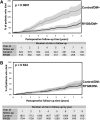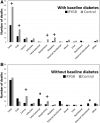All-Cause and Specific-Cause Mortality Risk After Roux-en-Y Gastric Bypass in Patients With and Without Diabetes
- PMID: 28760742
- PMCID: PMC5606311
- DOI: 10.2337/dc17-0519
All-Cause and Specific-Cause Mortality Risk After Roux-en-Y Gastric Bypass in Patients With and Without Diabetes
Abstract
Objective: This study assessed all-cause and specific-cause mortality after Roux-en-Y gastric bypass (RYGB) and in matched control subjects, stratified by diabetes status.
Research design and methods: RYGB patients were matched by age, BMI, sex, and diabetes status at time of surgery to nonsurgical control subjects using data from the electronic health record. Kaplan-Meier curves and Cox regression were used to assess differences in all-cause and specific-cause mortality between RYGB patients and control subjects with and without diabetes.
Results: Of the 3,242 eligible RYGB patients enrolled from January 2004 to December 2015, control subjects were identified for 2,428 (n = 625 with diabetes and n = 1,803 without diabetes). Median postoperative follow-up was 5.8 years for patients with diabetes and 6.7 years for patients without diabetes. All-cause mortality was reduced in RYGB patients compared with control subjects only for those with diabetes at the time of surgery (adjusted hazard ratio 0.44; P < 0.0001). Mortality was not significantly improved in RYGB patients without diabetes compared with control subjects without diabetes (adjusted hazard ratio 0.84; P = 0.37). Deaths from cardiovascular diseases (P = 0.011), respiratory conditions (P = 0.017), and diabetes P = 0.011) were more frequent in control subjects with diabetes than in RYGB patients with diabetes. RYGB patients without diabetes were less likely to die of cancer (P = 0.0038) and respiratory diseases (P = 0.046) than control subjects without diabetes but were at higher risk of death from external causes (P = 0.012), including intentional self-harm (P = 0.025), than control subjects without diabetes.
Conclusions: All-cause mortality benefits of RYGB are driven predominantly by patients with diabetes at the time of surgery. RYGB patients with diabetes were less likely to die of cardiovascular diseases, diabetes, and respiratory conditions than their counterparts without RYGB.
© 2017 by the American Diabetes Association.
Figures


Comment in
-
Comment on Lent et al. All-Cause and Specific-Cause Mortality Risk After Roux-en-Y Gastric Bypass in Patients With and Without Diabetes. Diabetes Care 2017;40:1379-1385.Diabetes Care. 2018 Feb;41(2):e19. doi: 10.2337/dc17-1895. Diabetes Care. 2018. PMID: 29358473 No abstract available.
-
Response to comment on Lent et al. All-Cause and Specific-Cause Mortality Risk After Roux-en-Y Gastric Bypass in Patients With and Without Diabetes. Diabetes Care 2017;40:1379-1385.Diabetes Care. 2018 Feb;41(2):e20. doi: 10.2337/dci17-0055. Diabetes Care. 2018. PMID: 29358474 Free PMC article. No abstract available.
References
-
- Fontaine KR, Redden DT, Wang C, Westfall AO, Allison DB. Years of life lost due to obesity. JAMA 2003;289:187–193 - PubMed
-
- Grundy SM, Benjamin IJ, Burke GL, et al. . Diabetes and cardiovascular disease: a statement for healthcare professionals from the American Heart Association. Circulation 1999;100:1134–1146 - PubMed
Publication types
MeSH terms
Grants and funding
LinkOut - more resources
Full Text Sources
Other Literature Sources
Medical
Research Materials

